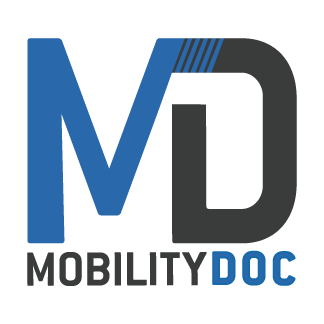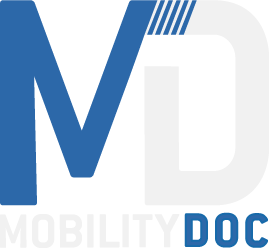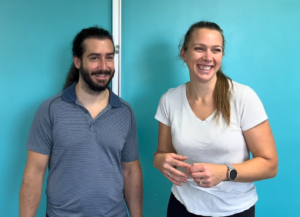Are you tired of that nagging foot pain slowing you down? Well, get ready for some eye-opening insights. As active people, avid runners, and physical therapists, we’re here to shed light on some surprising factors that might be causing your foot pain. Even though these insights are geared towards runners, they’re good for hikers, walkers, however you stay active! We’re going to break down how the foot, big toe, and calf are all connected. Then we’ll share some flexibility exercises to reduce your foot pain while running.
The Big Toe Dilemma
Let’s start with something you might not expect: your big toe! That’s right, this little piggy plays a huge role in your running game. Here’s the scoop:
– Big toe flexibility is crucial for proper glute activation
– A stiff big toe can throw off your entire running/walking mechanics – this can lead all the way up the chain potentially causing knee and hip issues
– Improved toe mobility can lead to better power and stability


When your big toe doesn’t have proper range of motion, we start relying on other parts of the foot and body to get the work done for us. If you’re dealing with plantar plate issues, pain and even stress fractures on the outside of your foot, you may need to look at the flexibility of your big toe! Who knew such a small part of your foot could make such a big difference?
The Foot
Ogres are like onions, and so are our feet. We’ve talked before about how there are different layers of muscle within the body. The outermost layer is called extrinsic muscle(s) while others buried deeper are intrinsic muscles. The foot is composed of many small bones that require layers of muscles and tendons to help us stabilize and move. Some begin and end within the foot while others run all the way up through our calf.

Today we are working on mobilizing the muscles and connective tissue within the foot and calf to help alleviate foot pain while running. It’s important to know and understand all these layers of muscles and tendons work together to help you stand, walk, run, you name it!
The Calf-Foot Connection
Now, let’s talk about the dynamic duo: your calves and feet. These two are more connected than you might think!
– Muscles and tendons run from your calf all the way into your foot
– Tight calves can lead to increased stress on your feet
– Some of these muscle and flexor attachment points may be causing pain in the heel, big toe, and bottom of your foot!


There are 3 main intrinsic muscles that are deep within your calf that attach into the bottom of the foot. The flexor hallucis longus, the posterior tibialis, and the flexor digitorum longus. One we commonly find issues with is the flexor hallucis longus. This tendon attaches essentially at the base of your big toe. Why is that important? Because if it’s tight it might be pulling on the attachment point. That pulling may be contributing to your foot pain and limited flexibility of the big toe!
Flexibility: Your New Best Friend
So, what’s the secret sauce to avoiding foot pain while running? Proper mobility through your foot and calf. Our definition of Mobility is a combination of flexibility, stability, and strength. Since this is a pretty complex issue we’re going to focus on the first aspect of flexibility. Without proper flexibility, it doesn’t matter how much strength you have, you won’t be able to use that strength at it’s full potential.
Foot, Big Toe, and Calf Flexibility Exercises
Ready to kick foot pain to the curb? Try these simple exercises:
For the Foot
 It’s important the ball is small enough and hard enough that it can get into those deep layers of muscle. Begin by sitting down with the ball on the floor. Apply pressure with your foot onto the ball. Use the ball to scan the entire bottom of the foot. Don’t just go where the source of pain is. You might be surprised with sensitivity you find somewhere else including in the heel! Do this for 1-2 minutes
It’s important the ball is small enough and hard enough that it can get into those deep layers of muscle. Begin by sitting down with the ball on the floor. Apply pressure with your foot onto the ball. Use the ball to scan the entire bottom of the foot. Don’t just go where the source of pain is. You might be surprised with sensitivity you find somewhere else including in the heel! Do this for 1-2 minutes
 Use your thumbs to massage into the bottom of your foot. Much like we did with the ball, you want to scan the entire area. We like this technique because we it’s a little more precise than the ball and you can use a little more pressure.
Use your thumbs to massage into the bottom of your foot. Much like we did with the ball, you want to scan the entire area. We like this technique because we it’s a little more precise than the ball and you can use a little more pressure.
Pro Tip: Feel where your toes connect to your foot. That is called the plantar plate. We like going around each of the bones and massaging in between. You’ll target hard to reach connective tissue that can fall victim to overcompensations.
 While being seated, bring your leg into a figure 4 position (the same as how we were for the self massage). Make sure your foot isn’t turning under or open but is straight. Dorsiflex (flex) your ankle while pulling back on your big toe. You want to hold this for 30 sec/side. While holding continue flexing your ankle the entire time. The ability of your big toe to extend directly relates to your ankle’s ability to flex!
While being seated, bring your leg into a figure 4 position (the same as how we were for the self massage). Make sure your foot isn’t turning under or open but is straight. Dorsiflex (flex) your ankle while pulling back on your big toe. You want to hold this for 30 sec/side. While holding continue flexing your ankle the entire time. The ability of your big toe to extend directly relates to your ankle’s ability to flex!
For the best results we like to massage with the ball or do self massage followed by the big toe stretch. Alternate between the 2 exercises for 3 rounds before moving onto the calf exercises.
For the Calf
 Foam rolling through the entire back of the calf is a great way help get those fibers loosened up. You want to do the entire calf from top to bottom, side to side. Don’t miss a spot! Do this for 1.5 minutes. For the last 30 seconds hold in an area that is tender and “floss it” by moving your ankle and toes. Keep in mind you want your foot moving in the proper orientation. Keep it straight! We know it sounds long but trust us it’s going to give you results!
Foam rolling through the entire back of the calf is a great way help get those fibers loosened up. You want to do the entire calf from top to bottom, side to side. Don’t miss a spot! Do this for 1.5 minutes. For the last 30 seconds hold in an area that is tender and “floss it” by moving your ankle and toes. Keep in mind you want your foot moving in the proper orientation. Keep it straight! We know it sounds long but trust us it’s going to give you results!
Pro Tip: You don’t have to hold yourself up with your arms the entire time. Lift up just enough to scoot yourself up and down. It’s a lot less strain on your shoulders!
 We’re leveling up one of our favorite calf stretches by adding muscle floss (if you don’t have a muscle floss band this stretch is still amazing but we highly recommend investing in one! It’s not too expensive and it’s very versatile). Start by wrapping the muscle floss band around the belly of your calf. You want to pull on the band with about 70% tension. Once you’re wrapped get into a down dog stretch and shift over to the leg with the muscle floss band on it. Hold the stretch for 30 sec/leg. This technique stretches the calf while restricting blood flow. When you release the band fresh blood rushes to the area to aid in healing.
We’re leveling up one of our favorite calf stretches by adding muscle floss (if you don’t have a muscle floss band this stretch is still amazing but we highly recommend investing in one! It’s not too expensive and it’s very versatile). Start by wrapping the muscle floss band around the belly of your calf. You want to pull on the band with about 70% tension. Once you’re wrapped get into a down dog stretch and shift over to the leg with the muscle floss band on it. Hold the stretch for 30 sec/leg. This technique stretches the calf while restricting blood flow. When you release the band fresh blood rushes to the area to aid in healing.
Alternate these 2 exercises for 3 rounds!
Watch our How To Fix Foot Pain While Running Video with a Detailed Anatomy Lesson!
Not Challenging Enough?
It’s important to note that all of these exercises have different progressions but we’re starting with the basics. You should be able to do all of these easily and without feeling pain or a stretch before moving onto something harder. Remember, when we run we take the same step thousands of times. That means consistency is key to alleviate your foot pain while running. Make these exercises part of your daily routine for best results.
The Bottom Line
Foot pain while running doesn’t have to be your constant companion. By focusing on big toe flexibility and calf-foot mobility, you can significantly reduce discomfort. It’s all about creating a harmonious relationship between all parts of your lower body.
So, next time you lace up for a run, give a little extra love to your toes and calves. Your feet will thank you, and you might just find yourself enjoying your runs more than ever! Stay tuned as we get into stability and strength to not just keep your new found flexibility, but transition it into stronger healthier feet for pain free running!
Bulletproof Your Feet and Ankles
Let’s be real foot pain blows. It starts creeping into everything you do because you end up compensating through your hips and knees and then all of a sudden everything hurts. You stop and think… how did I get here? It usually points back to one little thing that you told yourself “it’ll be fine!” “It’ll get better on it’s own…”

What if instead you decided to take on a 4 week systematic approach with bite sized mobility work every day. In just 15 – 30 minutes a day MDRx Foot and Ankle Recovery will help you come back stronger. The program covers improving the flexibility stability and strength of your foot, calf, ankle, and even hips. This general program is perfect for tweaks, plantar fasciitis, and bridging the gap post traditional physical therapy after a break, strain, or bigger incident.
Save yourself the frustration of trying to know what will work. These exact exercises have helped thousands of patients who began by limping in, but are now proudly walking out of our doors. Start MDRx Foot and Ankle Recovery today.






